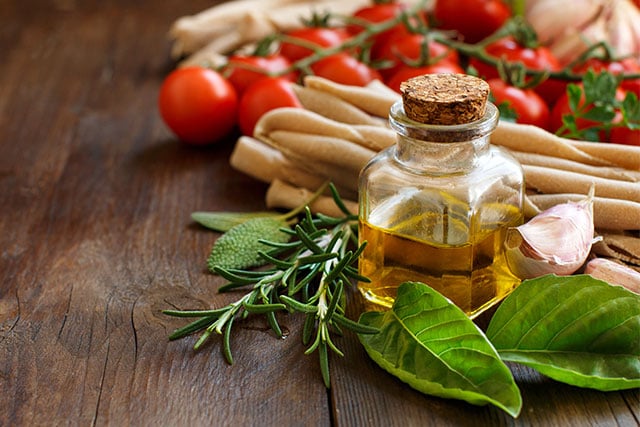
It's not uncommon for adults to be concerned about their salt intake. After all, salt has been linked to high blood pressure, heart attacks, and strokes. Yet the concern is greater for older adults, because of the way taste buds change as we age. Some of our taste sensors actually die over time, so more flavor is required to stimulate them. In order to compensate for the loss in flavor, seniors often over-salt their food.
So how do you make food healthy and flavorful without all that additional salt? That's a challenge Chef Brett tackles every day as the culinary director at Terracina Senior Living, a senior living campus managed by The Goodman Group in Naples, Florida.
Build Flavor First, Add Salt Later (If At All)
"You want to add flavor to food before salt," Brett explains. Slow roasting with herbs and spices builds natural flavors, so he has developed seven different blends that are used in the kitchens at the campus.
"We really only use a little finishing salt, a little sprinkle to wake the food up a little bit, right before we serve it. And we use Kosher salt, or a bigger grain salt, because the bigger grain gives you a better flavor profile than an iodized salt or a table salt."
When the food looks good and tastes delicious, there is less temptation – or need – to add more salt. Still, Chef Brett also takes control of the salt at the table. "We never put salt and pepper shakers on the table," he says. "We have salt and pepper grinders, which grind the peppercorns and the Kosher salt, so you actually use less salt to get the same amount of flavor. "
You Can Do It At Home
Chef Brett says you can make the same kinds of changes in your kitchen. He has eight easy steps to make delicious meals while using less salt.
- Don't salt food before cooking it. Salt added early in cooking gets diluted, even though the sodium remains. Instead, Brett says any salt that you add should be at the very end, to finish the food, so it actually adds flavor for your tastebuds.
- Cook meat on the bone. "When you cook meat on the bone, you get more flavor," says Brett. "Instead of cooking a boneless, skinless chicken breast, cook the whole chicken and just take the skin off before you serve it."
- Marinate meats to add flavor. Brett suggests a simple citrus marinade for chicken, or mixing Dijon mustard, garlic, fresh onion, and a little canola oil. You can even add white wine. "Just let it soak for 15 or 20 minutes to pick up all those flavors instead of relying on salt." Avoid store-bought marinades, though, because they tend to be heavy in salt and preservatives.
- Cook with fresh herbs. Keep a wide assortment of fresh herbs handy to season your food while cooking. Fresh herbs have more flavor. They release their essential oils during the cooking process, producing a lot of deep flavor, so Chef Brett is a big fan of roasting meat with a lot of herbs. "Chop some dill, sprinkle it on salmon and put it in the oven to roast," he says. "You don't need to sauté, which adds fat. The fish will pick up the flavor from those fresh herbs."
- Keep your pantry full of spices. Brett says they really are the "spice of life," and the secret to seasoning food without much salt. Experiment with combinations of flavors. "When you toast a spice, it tastes different than a raw spice," he says. "Use that to season, too." Note: Spices lose some flavor as they age and dry out, so Brett says you should replace them often.
- Avoid bullion cubes. They are basically chunks of salt. Use broths or stocks, instead, ideally shopping for lower sodium options.
- Use a grinder instead of a salt shaker. "The salt shaker is such an evil thing," Brett says. "We won't even put them on the table." Salt shakers use small grains and give you very little control, compared to the extra surface area and increased control with a grinder and kosher salt. "Grinders are great. Everyone should use them."
- Read the labels (and use the "5th ingredient" rule). When buying seasoning blends (like a poultry rub or chili seasoning) always check where salt sits on the ingredient list. "Salt should be the 5th ingredient or lower," Brett says. "Any higher than that, skip it. A dietician taught me that about twenty years ago." He says salt actually dries meat out, so beyond any health concerns, salty rubs don't work as well as herbs and spices, either.
How to Use Spice Blends
Chef Brett worked with a spice company to package the seven spice blends used in recipes at all of the senior living communities managed by The Goodman Group. There are different blends for pork, poultry, fish and seafood, beef and lamb, potatoes, and Asian recipes, along with a salt-free blend (similar to Mrs. Dash) for "salting" popcorn and other snacks.
What's in those blends? His pork spice has (in order), garlic, thyme, oregano, cumin, nutmeg, paprika, black pepper, red pepper, and then salt (9th on the ingredient list). Brett says you can find a lot of good products at the store, as long as you shop by reading the labels carefully.


